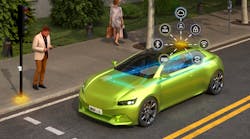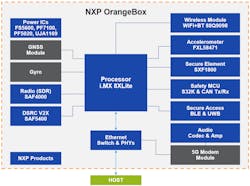What you’ll learn:
- How today’s automotive wireless connectivity solutions are typically distributed across various electronic control units (ECUs).
- How tomorrow’s automotive wireless connectivity solutions will be managed by a connectivity domain controller.
- How NXP’s OrangeBox from NXP provides a platform for prototyping and use-case development of next-generation automotive connectivity solutions.
As the number of automotive electronic subsystems balloons, the underlying architectures used to support internal and external connectivity are evolving to accommodate the ever-changing requirements of manufacturers and end-users.
Until relatively recently, the electronic subsystems in automobiles were predominantly based on flat distributed architectures. In this case, specific electronic control units (ECUs) are dedicated to certain functions, with each ECU having its own sensors and actuators.
Problems begin to arise with these architectures when software in so many ECUs needed to be updated. With such a high number of interconnected ECUs (sometimes more than 80), testing and verifying every possible software combination becomes very challenging.
To address these problems, the automotive industry is moving to concentrate electronic functions into fewer, larger ECUs by adopting domain-controller architectures that group similar functions together in a single “domain.” A related approach is zonal architectures—a vehicle’s functions (including their associated sensors and actuators) are grouped into zones based on their physical location, with each zone having its own zonal controller.
In parallel, the traditional automotive wiring harness is being replaced by a high-speed network in the form of automotive Ethernet. Such a network provides the time-sensitive-networking (TSN) capabilities required to enable engineers to design automotive networks with predictable latency and guaranteed bandwidth.
Uncontrolled Connectivity
We live in an increasingly connected world and automobiles are no exception, with both internal and external wireless interfaces growing dramatically. Prior to the year 2000, the only wireless interface in a car was typically an AM/FM radio tuner. The first Bluetooth hands-free car kit appeared on the market circa 2001. This was soon followed by a wide variety of increasingly sophisticated wireless connectivity solutions.
Today’s automotive wireless connectivity solutions are typically distributed across various ECUs. In the case of infotainment and the e-cockpit, for example, there may be Wi-Fi (for hotspots), Bluetooth, digital audio broadcasting (DAB), HD Radio, and SiriusXM, to name but a few.
With respect to body and comfort, which includes seats, doors, and windows, we find Bluetooth and ultra-wideband (UWB), with near-field communication (NFC) as a backup technology if all else fails. These can be used for applications like smart car access—detecting when a phone is in range and then determining where the phone is to know when to unlock the doors.
More recently, some automotive manufacturers and OEMs started adding cellular modems (currently 5G) to provide cloud connectivity as well as support telematics use cases. They’ve also started to add Wi-Fi as an external interface (in addition to having Wi-Fi as an internal interface).
The current trend toward software-defined vehicles—that is, vehicles whose features and functions are primarily enabled through software—requires the ability to upgrade the vehicle’s software from the cloud, which demands high-speed connectivity. If the vehicle is close to a Wi-Fi network, that’s going to be faster than a cellular connection. Manufacturers are even starting to use this approach in a production-line setting rather than plugging in an Ethernet cable.
Having been added ad hoc over time, these wireless interfaces to the outside world are typically spread all around the car. This leads to a variety of problems, including RF coexistence challenges and security.
Cybersecurity is now seen as a critical requirement. All of the wireless connectivity interfaces provide a means for data to get into the car from the outside world. Even broadcast systems like DAB, HD Radio, and Satellite Radio let the user download images and other files, any of which may be infected by malware (malicious software).
The ideal solution is to have a single point of entry into the car, allowing the data to be controlled and filtered using advanced firewall technology. Using such technology is almost impossible to do with existing distributed connectivity architectures.
Yet one more consideration is that different vehicles are created by different teams, each doing things in different ways. As a result, each new vehicle provides a new adventure when it comes to things like addressing RF coexistence challenges and ensuring data and system security.
Controlling Connectivity
One way to address the above concerns is to have all of the vehicle’s wireless connectivity managed by a single subsystem called a connectivity-domain controller (Fig. 1).
Having a single high-performance processor controlling every wireless interface means the system requires only a single instance of next-generation firewall (NGFW) technology. This enables consistent, state-of-the-art security protection to be applied to all traffic entering the vehicle.
In addition to facilitating cybersecurity, a connectivity-domain controller offers many other advantages, including managing any RF coexistence challenges and ensuring the desired quality-of-service (QoS) associated with each wireless interface. By means of its connection to the cloud via cellular or Wi-Fi, this approach also makes it easier to download, verify, and install the latest versions of any applications, drivers, and security software.
The connectivity-domain controller concept fits nicely into the modern vehicle architecture by providing a single connection into the automotive Ethernet network. Furthermore, it offers a scalable solution that can be deployed by multiple development teams working on different automotive platforms.
Automotive Connectivity Future
Although several OEMs are already working on their own proprietary solutions for automotive wireless connectivity, so too are semiconductor vendors like NXP. An example is its OrangeBox reference design and development platform to help other manufacturers, OEMs, and Tier 1 suppliers get started. OrangeBox is a comprehensive development platform providing extensive secure wireless connectivity to develop automotive solutions that meet both domain and zonal controller requirements (Fig. 2).
The OrangeBox incorporates the scalable i.MX 8XLite applications processor (AP), an S32K safety co-processor, and the wireless connectivity required to implement V2X, Wi-Fi, Bluetooth Low Energy (BLE), UWB, and cellular connectivity between the vehicle and the outside world in a secure and safe manner.
A key feature of the OrangeBox is the inclusion of modular upgradable components that use standard interfaces, thereby allowing it to address changing standards and requirements. For example, it supports Wi-Fi 6 + BT wireless connectivity and 5G cellular connectivity today, and it will be able to support Wi-Fi 7 + BT wireless connectivity and 6G cellular connectivity in the future.


